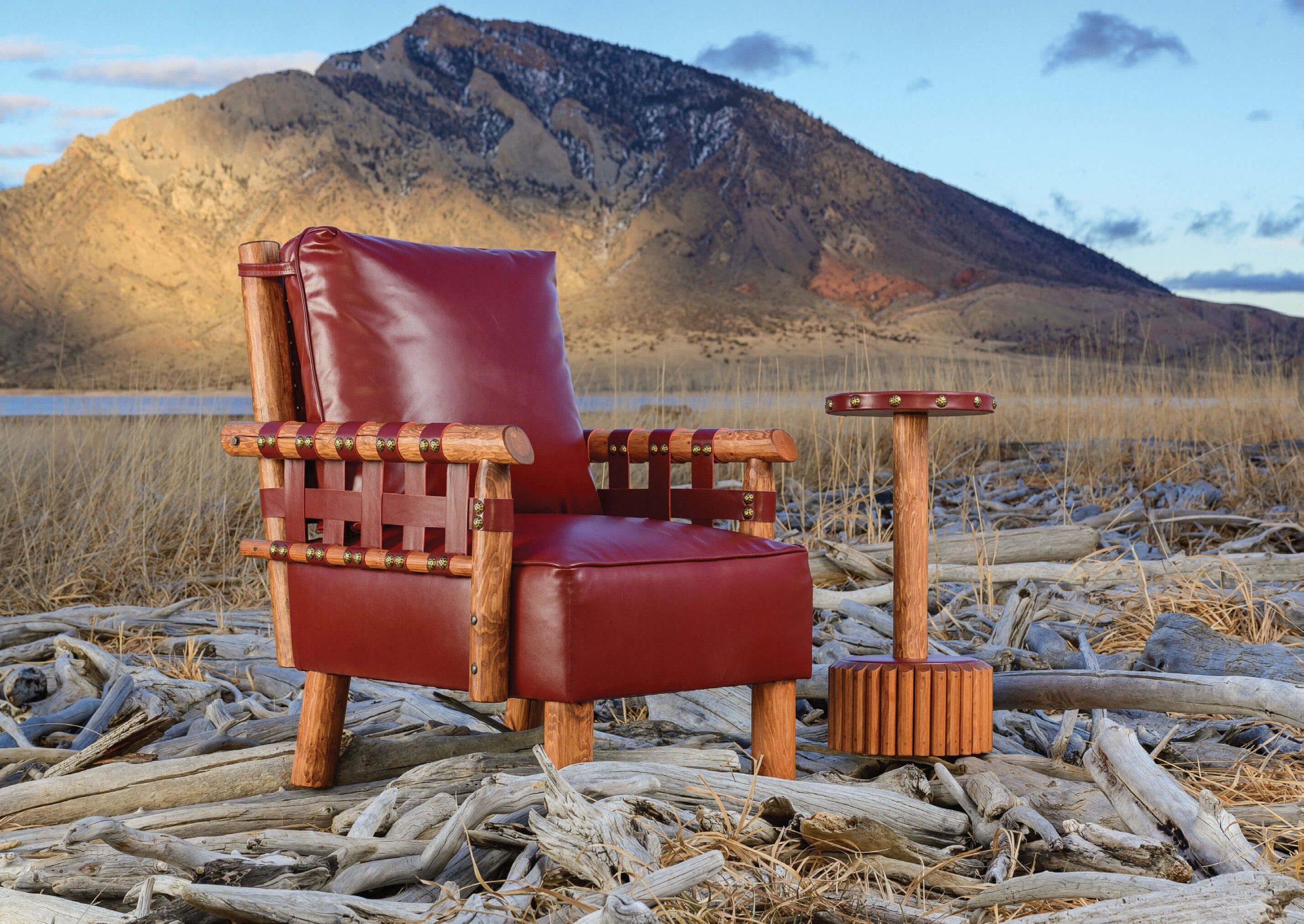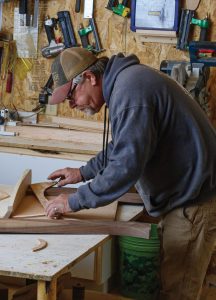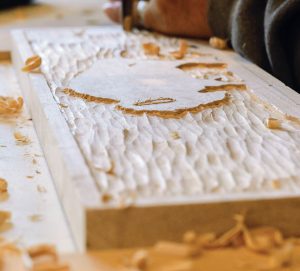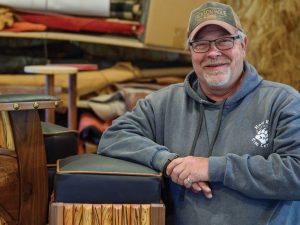
10 Apr In the Workshop: Cowboy Craftsman
Craftsman Tim Lozier is totally willing to try his hand at doing something new. Play in a country rock band? No problem. He taught himself how to play the drums, and 40 years later, he plays as a band’s lead drummer. Chase his passion as a Western furniture maker? Again, no sweat. He rolled up his sleeves and moved from his job in the oilfields of Cody, Wyoming to become one of the nation’s best designers and builders of custom Thomas Molesworth-reproduction furniture.

Tim Lozier builds a wingback chair in his workshop. His passion for building chairs came from working for another furniture company that closed, paving the way for him to open his own studio.
Lozier fell in love with woodworking while attending high school in upper Michigan. “We had a phenomenal industrial education with a woodshop class that taught me how to work with my hands and stretch my mind creatively,” he says. He did not practice woodworking at the professional level until he moved to Cody in 1989, where he worked as a sander for a local furniture company while soaking in the entire furniture-building process. Almost a decade later, he launched How Kola Furniture (“hello, friend” in Lakota Sioux) as a Thomas Molesworth-reproduction furniture studio.
The late Thomas Molesworth, who is credited with popularizing cowboy furniture that captured the spirit of the American West, built furniture in the 1930s to 1960s at his Cody workshop. His original pieces continue to increase in value today and are highly sought after at auction.

He hand-chisels all of the carvings on his furniture, including on the beds he designs.
Lozier is best known for crafting club and wing chairs, dining chairs, sofas, and recliners reminiscent of the Molesworth tradition by applying details such as vertical half-pole trim, chunky burls, leather, brass-tack trim, large paddle arms, and carvings of traditional Western and Indigenous motifs. “I choose to make Molesworth reproductions because I like the Western lodge look,” Lozier says. “My furniture is versatile enough to live in a rustic cabin or in a contemporary home.”

Lozier stands in How Kola’s studio, propped on a custom ottoman that is in the process of being built. He builds up to five pieces of furniture at once, all in various stages of production. Switching between designs gives him time to think about next steps and inspires new ideas, he says.
He customizes furniture based on his clients’ desires to create special pieces for their homes. “If someone has an idea, I’m willing to build it,” he says. “I listen to their input about materials and colors, and we email back and forth as I create and tweak drawings that capture their style. Then, I start building.”
Every piece designed in How Kola’s small studio is primarily built by Lozier every step of the way. His intimate involvement with each piece is attributable to his passion for Molesworth’s designs. He uses authentic materials — such as Chimayo-covered chair cushions handwoven by Navajo artisans in New Mexico — and sources as many of his raw materials — leather and wood, such as Douglas fir, pine, and hemlock — as close to home as possible, and always from areas throughout the Western U.S. He tackles materials sourcing like everything else he has ever done: He digs in to flatten the learning curve and thoughtfully takes action to implement his newfound knowledge.

Lozier builds a variety of furniture, including Molesworth-inspired dressers, club chairs, and dining chairs with carvings specified by his clients. The Chimayo-covered club chair with rounded arms is what he coined “Modern Molesworth,” and in 2022 it received an award during the Western Design Conference.
While How Kola’s reproductions symbolize the Old West, Lozier also takes great pride in one-of-a-kind creations he calls “Modern Molesworth.” He starts with iconic Molesworth furniture forms and adds his creative spin to create novel Western designs. He may design a club chair, for example, with rounded arms instead of the traditional paddle-style, adding carvings and painted scenes that he dreams up. Many of his modernized furniture designs feature square legs instead of the traditional rounded ones for a more contemporary aesthetic.
Like so many artisans, Lozier finds inspiration when he is away from the studio as well. He enjoys camping with his family and often uses the time to think about future designs. “Camping goes hand-in-hand with finding wood that inspires me. Getting outdoors clears my mind and leads to new ideas,” he says. “A walk along the river may turn up a log that I can see becoming a lamp.”
While How Kola Furniture is best known for its chairs and sofas, Lozier also builds tables, desks, beds, benches, nightstands, and accessories like luggage racks. His clients include national and international commercial and residential customers, for whom he produces single custom pieces or outfits entire homes based on their needs. While most of his furniture is commissioned, it’s possible to buy one-off pieces from his online store or through By Western Hands or Rustic Artistry. And, while the Western Design Conference awarded Lozier as best mixed-media artist in 2022 for one of his Chimayo-woven cushioned chairs, he is low-key with his innovations. A thriving group of enthusiastic How Kola furniture owners spreads the news organically through word-of-mouth recommendations of the detailed artisanship, and those positive reviews keep Lozier busy building new furniture.
“Being a furniture builder in the West is an honor,” he says. “I find that people appreciate what I do and are willing to wait a few weeks for custom furniture that lasts.”
Sometimes, publicity breeds copycat pieces, but that never bothers Lozier. “If someone copies one of my furniture creations, I consider it an honor,” he says. “I am more focused on building legacy pieces that can be passed on for generations; to me, that is the true test of craftsmanship. I am happy if someone considers my work good enough to replicate.”
Dana W. Todd is a professional writer specializing in interior design, real estate, luxury home building, landscape design, architecture, and fine art subjects.
Veteran-owned and -operated WrightLight Imagery in Cody, Wyoming was launched two years ago by husband-and-wife team Randy and Sheila Quarles. Though Randy has been looking through a camera lens for nearly 20 years, he recently used his GI Bill to earn an associate degree in photography, which, when combined with his wife’s graphic design talents and experience, made for the perfect business marriage of experience and passion; wrightlightimagery.com.




No Comments